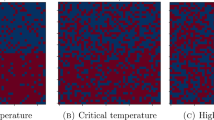Abstract
We consider a Glauber dynamics reversible with respect to the two-dimensional Ising model in a finite square of sideL, in the absence of an external field and at large inverse temperature β. We first consider the gap in the spectrum of the generator of the dynamics in two different cases: with plus and open boundary conditions. We prove that, when the symmetry under global spin flip is broken by the boundary conditions, the gap is much larger than the case in which the symmetry is present. For this latter we compute exactly the asymptotics of −(1/βL) log(gap) asL→∞ and show that it coincides with the surface tension along one of the coordinate axes. As a consequence we are able to study quite precisely the large deviations in time of the magnetization and to obtain an upper bound on the spin-spin time correlation in the infinite-volume plus phase. Our results establish a connection between the dynamical large deviations and those of the equilibrium Gibbs measure studied by Shlosman in the framework of the rigorous description of the Wulff shape for the Ising model. Finally we show that, in the case of open boundary conditions, it is possible to rescale the time withL in such a way that, asL→∞, the finite-dimensional distributions of the time-rescaled magnetization converge to those of a symmetric continuous-time Markov chain on the two-state space {−m *(β),m *(β)},m *(β) being the spontaneous magnetization. Our methods rely upon a novel combination of techniques for bounding from below the gap of symmetric Markov chains on complicated graphs, developed by Jerrum and Sinclair in their Markov chain approach to hard computational problems, and the idea of introducing “block Glauber dynamics” instead of the standard single-site dynamics, in order to put in evidence more effectively the effect of the boundary conditions in the approach to equilibrium.
Similar content being viewed by others
References
D. Aldous, Markov chains with almost exponential hitting times,Stochastic Processes Appl. 13:305 (1982).
J. Chayes, L. Chayes, and R. H. Schonmann, Exponential decay of connectivities in the two-dimensional Ising model,J. Stat. Phys. 49:433 (1987).
R. L. Dobrushin and S. Shlosman, Constructive criterion for the uniqueness of Gibbs fields, inStatistical Physics and Dynamical Systems, J. Fritz, A. Jaffe, and D. Szász, eds. (Birkhauser, Basel, 1985), p. 347.
R. Dobrushin, R. Kotecký, and S. Shlosman,Wulff Construction. A Global Shape from Local Interaction (AMS, Providence, Rhode Island, 1992).
P. Diaconis and D. W. Stroock, Geometric bounds on the eigenvalues of Markov chains,Ann. Appl. Prob. 1(1):36 (1991).
D. Fisher and D. Huse,Phys. Rev. B 35:6841 (1987).
C. M. Fortuin, P. W. Kasteleyn, and J. Ginibre, Correlation inequalities on some partially ordered sets,Commun. Math. Phys. 22:89 (1971).
R. Holley, Possible rates of convergence in finite range attractive spin systems,Contemp. Math. 41:215 (1985).
R. Kotecký and E. Olivieri, Droplet dynamics for asymmetric ising models,J. Stat. Phys. 70:1121 (1993).
R. Kotecký and E. Olivieri, Shapes of growing droplets: A model of escape from a metastable phase, preprint (1993).
M. Jerrum and A. Sinclair, Approximating the permanent,SIAM J. Comput. 18:1149 (1989).
M. Jerrum and A. Sinclair, Polynomial-time approximation algorithms for the Ising model.SIAM J. Comput. 22:1087 (1993).
T. Ligget,Interacting Particle Systems (Springer-Verlag, Berlin, 1985).
G. Lawler and A. Sokal, Bounds on theL 2 spectrum for Markov chains and Markov processes: A generalization of Cheeger inequality,Trans. Am. Math. Soc. 309:557 (1988).
J. Lebowitz and R. Schonmann, On the asymptotics of occurrence times of rare events for stochastic spin systems,J. Stat. Phys. 48:727 (1987).
S. Lu and H. T. Yau, Spectral gap and logarithmic Sobolev inequality for Kawasaki and Glauber dynamics,Commun. Math. Phys. 156:399 (1993).
F. Martinelli, Low temperature stochastic spin dynamics: Convergence to equilibrium, metastability and phase segregation, inProceedings X International Conference Mathematical Physics Leipzig, K. Schmudgen ed. (Springer-Verlag, Berlin, 1991).
F. Martinelli and E. Olivieri, Approach to equilibrium of Glauber dynamics in the one phase region I: The attrictive case,Commun. Math. Phys., in press (1992).
F. Martinelli and E. Olivieri, Approach to equilibrium of Glauber dynamics in the one phase region II: The general case,Commun. Math. Phys., in press (1992).
F. Martinelli, E. Olivieri, and R. Schonmann, For Gibbs state of 2D lattice spin systems weak mixing implies strong mixing,Commun. Math. Phys., in press (1992).
Ogielski, Dynamics of fluctuations in the order phase of kinetic Ising model,Phys. Rev. Lett. 36(13):7315 (1987).
C. Pfister, Large deviations and phase separation in the two dimensional Ising model,Helv. Phys. Acta 64:953 (1991).
E. Scoppola, Renormalization group for Markov chains and application to metastability,J. Stat. Phys., in press (1993).
R. Schonmann, Slow droplet driven relaxation of stochastic Ising models in the Vicinity of the phase coexistence region,Commun. Math. Phys., in press (1993).
R. Schonmann, Second order large deviations estimates for ferromagnetic systems in the phase coexistence region,Commun. Math. Phys. 112:409 (1987).
S. Shlosman, The droplet in the tube: A case of phase transition in the canonical ensemble,Commun. Math. Phys. 125:81 (1989).
A. Sinclair, Improved bounds for mixing rates of Markov chains and multicommodity flow,Combinatorics Probability Computing 1:351 (1992).
D. W. Stroock and B. Zegarlinski, The logarithmic Sobolev inequality for discrete spin systems on a lattice,Commun. Math. Phys. 149:175 (1992).
L. Thomas, Bounds on the mass gap for the finite volume stochastic Ising models at low temperatures,Commun. Math. Phys. 126:1 (1989).
Author information
Authors and Affiliations
Rights and permissions
About this article
Cite this article
Martinelli, F. On the two-dimensional dynamical Ising model in the phase coexistence region. J Stat Phys 76, 1179–1246 (1994). https://doi.org/10.1007/BF02187060
Received:
Accepted:
Issue Date:
DOI: https://doi.org/10.1007/BF02187060




